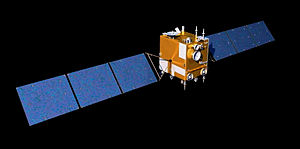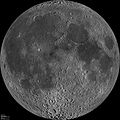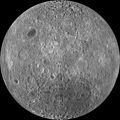- Chang'e 2
-
Chang'e 2 
Operator CNSA Mission type Orbiter / impactor Satellite of The Moon Launch date 2010-10-01, 10:59:57 UTC Carrier rocket Long March 3C Launch site Xichang Satellite Launch Center
Xichang, Sichuan, ChinaMission duration > 6 months
elapsed: 1 year, 1 month and 19 daysCOSPAR ID 2010-050A Mass 2,500 to 2,600 kg (5,500 to 5,700 lb) Orbital elements Apoapsis 100 km (62 mi) Periapsis 15 km (9.3 mi) Instruments Main instruments Charge-Coupled Device (CCD) improved stereo camera [1]
Laser altimeter
Gamma/X-ray Spectrometers
Microwave DetectorSpatial resolution 10 meter at 100 km altitude and 1.5 meter at 15 km altitude Chang'e 2 (Mandarin: [tʂʰɑ̌ŋ.ɤ̌ ɑ̂ɻ xɑ̂ʊ], simplified Chinese: 嫦娥二号; traditional Chinese: 嫦娥二號; pinyin: Cháng'é èr hào), is a Chinese unmanned lunar probe that was launched on 1 October 2010.[2] It was a follow-up to the Chang'e 1 lunar probe, which was launched in 2007. Chang'e 2 was part of the first phase of the Chinese Lunar Exploration Program, and conducted research from a 100-kilometer-high lunar orbit in preparation for a 2013 soft landing by the Chang'e 3 spacecraft.[3] Chang'e 2 was similar in design to Chang'e 1, although it featured some technical improvements, including a more advanced onboard camera with a resolution of one meter. Like its predecessor, the probe was named after a Chinese goddess of the moon. The total expenditure for the Chang'e 2 mission was approximately CN¥900 million, or US$134 million.[4]
After completing its primary objective, the probe left lunar orbit for the L2 Lagrangian point, to test the Chinese tracking and control network, making the China National Space Administration the third space agency after NASA and ESA to have visited this point.[5] It entered orbit around L2 on August 25, 2011, and is expected to remain there until the end of 2012.[6][7]
Contents
Design
Chang'e 2 was broadly similar to the Chang'e 1 mission, but had important differences. While Chang'e 1 operated in a 200-kilometer orbit, Chang'e 2 flew at only 100 kilometers, allowing for higher-resolution images and more precise science data. The probe also possessed a higher-resolution camera, able to resolve features as small as 1 metre across from orbit. According to Qian Huang of the Shanghai Astronomical Observatory and Yong-Chun Zheng of the NAOC,[8] the spacecraft also had a shorter Earth-to-Moon cruise time of 5 days, rather than 12 days. The probe's launch rocket had two more boosters to accomplish this more direct route to the Moon. Furthermore, its laser altimeter's footprint was smaller than Chang'e 1's, achieving 5-meter vertical accuracy in its estimate of the Moon's radius. It also pulsed more frequently - five times per second rather than just once per second, as Chang'e 1's altimetere did. Additionally, the probe's main camera had a spatial resolution of 10 meters, rather than 120 meters.
Late in the mission, Chang'e 2's orbit was lowered to an elliptical one, with the same apolune (100 kilometers) as Chang'e 1, but with a perilune of only 15 kilometers. Tracking for the mission was performed with an X-band radio capability, which was not available for Chang'e 1.
Zheng also remarked that "the mission goals of CE-2 [were] focused into the high resolution image for the future landing site of CE-3 lunar lander and rover. The key technology about soft landing on the Moon will be tested in the CE-2 mission. The success of CE-2 will provide an important technical basis for the successful implementation of China's future lunar exploration."[8]
Mission summary
Chang'e 2 was launched on 1 October 2010 at 10:59:57 UTC aboard a Long March 3C rocket from Xichang Satellite Launch Center in Xichang, Sichuan.[2] The spacecraft entered an orbit with a perigee of 200 kilometers and an apogee of 380,000 kilometers, and separated from the carrier rocket as planned. It was the first time that a Chinese lunar probe directly entered an Earth-Moon transfer orbit without orbiting the Earth first.[9] After the launch, Chang'e 2 arrived in its lunar orbit within 4 days and 16 hours, much faster than the 12 days taken by Chang'e 1. Later, the probe lowered its orbit to 100 km (62 mi), with a perilune of 15 km (9.3 mi).[10] Chang'e 2 entered its 100 km working orbit on 9 October 2010 after three successful brakings.[11] On 8 November 2010, China announced the success of all of Chang'e 2's mission objectives,[12] and published lunar surface images with a resolution of up to 1.3 metres (4.3 ft).[13]
L2 mission
On 8 June 2011, Chang'e-2 completed its extended mission, and left lunar orbit for the L2 Lagrangian point, to test the Chinese tracking and control network.[14] The probe reached L2 on August 25, 2011 at 11:27 p.m. Beijing time (14:27 UTC), after a 77-day cruise. It is expected to remain there until the end of 2012.[6][15][16] The probe beamed its first batch of data from L2 in September 2011.[6]
Significance
The launch of the probe coincided with the National Day of the People's Republic of China, on October 1, in a symbolic celebration of the country's 61st anniversary.[17] After orbiting the Moon for nearly a year, the probe became the first object to reach the L2 Lagrangian point directly from lunar orbit, travelling further than any previous Chinese space probe.[18]
See also
- Chinese Lunar Exploration Program
- China National Space Administration
- Chang'e 1, Chang'e 2's immediate predecessor, launched in 2007
- Chang'e 3, a robotic lunar lander and rover, planned for launch in 2013
- Exploration of the Moon
- Future lunar missions
- Robotic exploration of the Moon
- 2010 in spaceflight
References
- ^ "Chang'e 2 poised for Friday's launch". Lunar Networks. 29 September 2010. http://lunarnetworks.blogspot.com/2010/09/change-2-poised-for-friday-launch.html. Retrieved 1 October 2010.[dead link]
- ^ a b Stephen Clark (1 October 2010). "China's second moon probe dispatched from Earth". Spaceflight Now. http://www.spaceflightnow.com/news/n1010/01change2launch/. Retrieved 1 October 2010.
- ^ Bodeen, Christopher (27 November 2009). "China to launch second lunar probe next October". The Associated Press. Archived from the original on 27 November 2009. http://www.webcitation.org/5lbDCuldI. Retrieved 27 November 2009.
- ^ Robert Pearlman (1 October 2010). "China launches lunar probe Chang'e II". collectSPACENews. http://www.collectspace.com/ubb/Forum32/HTML/000136.html#changeII_launch. Retrieved 3 October 2010.
- ^ SpaceDaily, "China's second moon orbiter Chang'e-2 goes to outer space", XNA, 10 June 2011
- ^ a b c "Chinese space craft travels 1.7 mn km deep into space", India Times, 2011-09-21. Retrieved 2011-10-17.
- ^ "Ching'e 2 to reaches liberation point 2" Xinhua.
- ^ a b http://www.planetary.org/blog/article/00002684/ Planetary.org. Retrieved 2011-10-05.
- ^ "China's 2nd lunar probe Chang'e-2 blasts off". Xinhua. 1 October 2010. http://news.xinhuanet.com/english2010/sci/2010-10/01/c_13539035.htm. Retrieved 1 October 2010.
- ^ Rui C. Barbosa (1 October 2010). "Long March 3C successfully launches Chang’e-2, China’s second lunar probe". NASAspaceflight. http://www.nasaspaceflight.com/2010/10/live-long-march-3c-launch-change-2-probe/. Retrieved 1 October 2010.
- ^ "China's second lunar probe completes final braking, enters working orbit". Xinhua News Agency. October 9, 2010. http://news.xinhuanet.com/english2010/china/2010-10/09/c_13548648.htm. Retrieved November 18, 2010.
- ^ "China announces success of Chang'e-2 lunar probe mission". Xinhua News Agency. November 8, 2010. http://news.xinhuanet.com/english2010/china/2010-11/08/c_13596211.htm. Retrieved November 18, 2010.
- ^ http://slide.news.sina.com.cn/c/slide_1_15699_13762.html
- ^ SpaceDaily, "China's second moon orbiter Chang'e-2 goes to outer space", XNA, 10 June 2011
- ^ Xinhua News, "Ching'e 2 to reaches liberation point 2"
- ^ http://www.planetary.org/blog/article/00003163/
- ^ Stumme, Susan (2 October 2010). "China launches second lunar probe". Agence France-Presse. http://www.google.com/hostednews/afp/article/ALeqM5h6WoG1-X_g-6H8vNAoNpYLqFUGcA?docId=CNG.27a028ad8f0542cd7177615afc42a4d3.5f1. Retrieved 3 October 2010.
- ^ "Ching'e 2 to reaches liberation point 2". 2011-08-27. http://news.xinhuanet.com/english2010/video/2011-08/27/c_131078520.htm.
External links
- Lunar mission timeline - NASA
- Recent Lunar missions - NASA
- Exploring the Moon - A history of lunar discovery from the first space probes to recent times
Robotic exploration of the Moon Programs Orbiters Planned Proposed Flybys Impactors Landers Rovers S. Return Cancelled See also - Moon
- Exploration of the Moon
- Colonization of the Moon
- Manned lunar spacecraft
- List of artificial objects on the Moon
- List of current and future lunar missions
- List of lunar probes
- Apollo
- CCCP manned lunar plan
Bold italics indicates active missionsChinese spacecraft Earth observation Communication and
engineering testData relay satellite system Tianlian-1 (Tianlian I-01)
In development: Tianlian-2Positioning Astronomical observation Double Star (joint ESA)
In development: Solar Space Telescope · Hard X-ray Modulation Telescope · KuafuLunar and planetary
explorationChang'e 1 (Chinese Lunar Exploration Program) · Chang'e 2
In development: Chang'e 3 · Yinghuo 1 · Deep space explorationChina National Space Administration (CNSA) Robotic programs PastCurrentChang'e program (Chang'e 2)In developmentHuman spaceflight
programsCurrentIn developmentPast missions Spaceports People ScientistsDu Qinghua · Fan Ruixiang · Hu Haichang · Huang Chunping · Long Lehao · Luan Enjie · Ouyang Ziyuan · Qi Faren · Qian Xuesen · Sun Laiyan · Wan Hu · Wang Yongzhi · Wei Yiqing · Ye Peijian · Zhuang Fenggan · Zhang Guitian · Zhao Jiuzhang · Zhu MiaolongAstronautsCategories:- Chinese space program
- 2010 in spaceflight
- Chinese Lunar Exploration Program
- Lunar spacecraft
- Unmanned spacecraft
Wikimedia Foundation. 2010.



